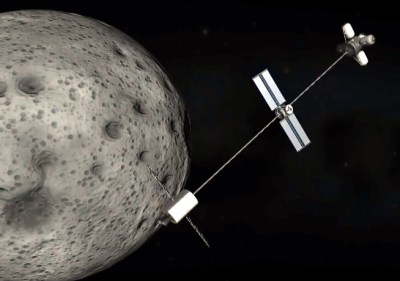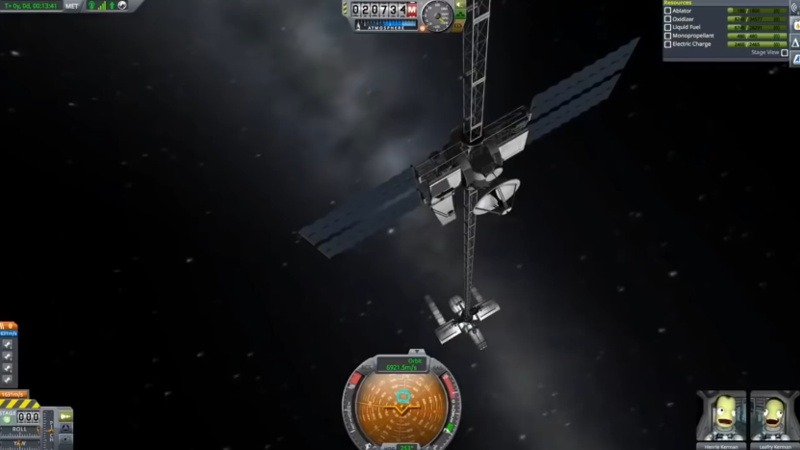Fans of the lusciously voiced space aficionado [Scott Manley] will know he often uses Kerbal Space Program (KSP) in his videos to knock together simple demonstrations of blindingly complex topics such as orbital mechanics. But as revealed in one of his recent videos, YouTube isn’t the only place where his KSP craft can be found these days. It turns out he used his virtual rocket building skills to help the creators of Netflix’s Stowaway develop a realistic portrayal of a crewed spacecraft in a Mars cycler orbit.
The Mars cycler concept was proposed in 1985 by Buzz Aldrin as a way to establish a long-term human presence on the Red Planet. Put simply, it describes an orbit that would allow a vehicle to travel continuously between Earth and Mars while needing only an occasional engine burn for course corrections. The spacecraft couldn’t actually stop at either planet, but while it made a close pass, smaller craft could rendezvous with it to hitch a ride. The concept can be thought of as a sort of interplanetary train: where passengers and cargo are picked up and dropped off at “stations” above Earth and Mars. It’s worth noting that a similar cycler orbit should be possible for Earth-Venus trips, but nobody really wants to go there.

The writers of Stowaway wanted their film to take place on a Mars cycler, and to avoid having to create the illusion of weightlessness, they wanted their fictional craft to also have some kind of artificial gravity. The only problem was, they weren’t sure what that would actually look like. So they reached out to [Scott], who in turn used KSP to throw together a rough idea of how such a ship might work in the real-world.
As you can see in the video below, the CGI spacecraft shown in the film’s recently released trailer ended up bearing a strong resemblance to its KSP prototype. While naturally some artistic license was used, [Scott] is excited by what he’s seen so far. The spinning spacecraft, which uses a spent upper stage to counterbalance its crew module and features a stationery utility node at the center, certainly looks impressive; all the more so with the knowledge that it’s based on sound principles.
While Netflix has had a hand in some surprisingly realistic science fiction in the past, they’ve also greenlit some real groan-worthy productions (if you haven’t watched Away, don’t). So until we can see the whole thing for ourselves, we can only hope that [Scott]’s sage advice will allow the crew of Stowaway to fly safe.

















I take exception to “nobody wants to go there”! That linked article explains “At an altitude of approximately 50 kilometers, conditions inside the Venusian atmosphere… (are) almost identical to surface-level pressures on Earth, and the average temperature is cool enough that liquid water can form”. And the possibilities for… Zeppelins! Awesome-sauce! Really, Mars is great for non-human exploration, but an incredible waste of resources to bring humans. People don’t even like to travel the Sahara, and Mars is an exceptionally cold, empty desert planet with no sandworms or spice. So, yes, people want to go to Mars, but they are all odipútse. In KSP, life support simply has not been implemented into the game, so no wonder Kerbal fans speculate about Mars. Because once you start factoring human life support into the Mars scenarios, Mars stops being fun. I also think it no coincidence that Venus is the goddess of love, and of course nerds are terrified at the faintest possibility of that, even in the distant future in outer space. Imagine getting rejected yet again, when you may be the only eligible mate within 216 million kilometers. I’m sure that’s an underlying reason for Venus neglect!
Life support is more optional in KSP. I know that technically they are mods, but they have been around a long time and play just like a DLC. I’ve flown to Duna with life support and it is a pain and a half. That being said, people love dark souls.
Maybe they should try Stationeers if they want more realistic.
Kerbals are green because they are plants: they subsist on sunlight.
Kerbals are plants!? I wonder how they would taste with hollandaise?
Recreate the events of the epic anime within KSP…
“Royal Space Force: The Wings of Hollandaise”
Yeah… for the plot though… designing a space habitat for three people and not having enough oxygen generating capacity to handle at least twice that would run the risk of killing the inhabitants anyways.
Something they learned in the Biosphere 1 and 2 experiments where they started to run out of oxygen. They didn’t close off the bottom of the structure, so soil bacteria started consuming their oxygen faster than it could be replenished.
Likewise on a space ship, suppose you have something that consumes oxygen, like a small fire. Oops, there goes our months of reserves designed to last only just to our destination. Who would stock up such a mission?
“Reserves” would for those cases when the oxygen recycling plan would not be working. Since a fire wouldn´t destroy the oxygen, just trap it into CO2 or other compounds, that shouldn´t be a very big problem.
Of course, in a spaceship, means of containing and dealing with fires are much more important ( and different ) than on more earthly vehicles.
But if your fire damages the CO2 recycling plant, well, then we have material for a couple of fast-paced episodes …. :)
If you have a CO2 recycling plant that can only barely manage three people, that would also be a cheap plot point, because anything involving people in a life-support or safety role is generally overbuilt at least two times to the demand, and then doubled up in case it breaks – basically for the point that you’d at least have double redundancy in the system.
Otherwise, building a space station that’s supposed to shuttle between the planets for decades is a virtually guaranteed death sentence. It’s going to fail at some point, and without redundancy the crew will surely die.
I only looked at the trailer quickly, but didn’t the captain say that the life support system was damaged as well?
“Designing a space habitat for three people and not having enough oxygen … to handle at least twice that would .. risk of killing the inhabitants”. Sure it would, and it would never be built today, but the programme isn’t set today, it’s in the future, where the cycler is just another industrial facility, built as cheaply as possible, in an environment where no national laws or standards (probably) apply and every penny and corner are cut. It would be like an oil rig in international waters, built in China, Registered in Liberia, crewed by Third World paupers and run by Mr. Burns today. You know cheap as f**k and twice as dangerous!
If that were the case, then why is it manned instead of robotic?
Probably humans are both more resourceful than robots and a hell of a lot cheaper. There are over 7,000,000,000 humans on earth, you can “buy” them for peanuts and kill millions of them and nobody will give a damn.
What was wrong with Away?